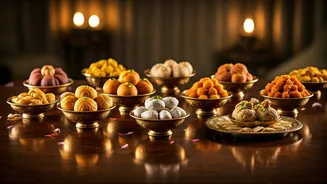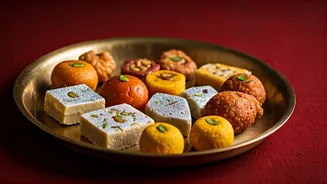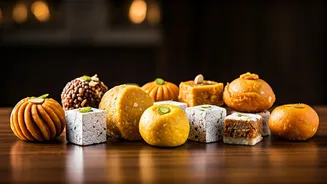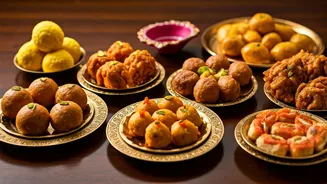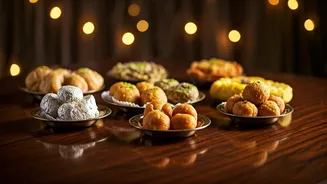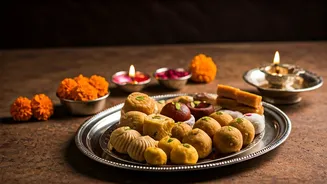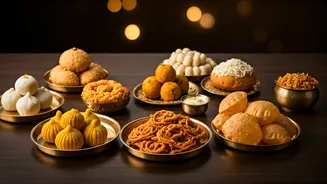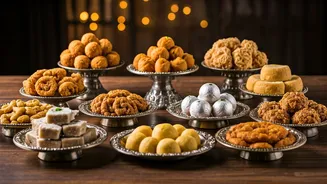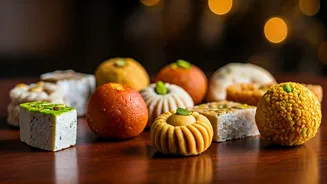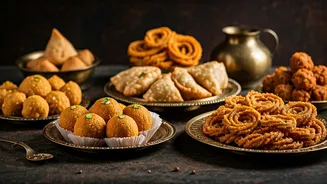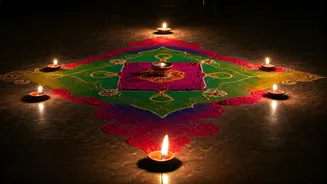Sweet Offerings Begin
The Diwali festivities often commence with the presentation of sweets, symbolizing happiness and auspicious beginnings. These treats are not merely consumed;
they are an integral part of the rituals, offered to the deities as a token of devotion. It is believed that these sweets bring divine blessings. The offerings usually include various types of mithai, each with its unique flavor and significance. These selections demonstrate the importance of starting the festive season with a sense of sweetness and gratitude. The practice of offering sweets underlines the significance of sharing joy and prosperity.
Laddoo's Divine Place
Laddoos, round and delightful, hold a prominent position in offerings to Lord Ganesha, often considered his favorite. These are traditionally made with gram flour, sugar, and ghee, often with nuts, such as cashews or pistachios. There's a wide range of laddoos, like motichoor, besan, and boondi laddoos. The significance of laddoos goes beyond their taste, with each element symbolizing different blessings. The shape of the laddoo, round and whole, reflects completeness and the cyclical nature of life. The sweetness of the laddoo represents joy and prosperity. The act of offering laddoos is a way to ask for the blessings of Lord Ganesha in terms of wisdom and prosperity.
Kheer: A Creamy Delight
Kheer, a creamy rice pudding cooked in milk and sweetened with sugar, is a favored sweet during Diwali. It represents purity and the abundance of blessings. Typically infused with cardamom, saffron, and nuts such as almonds and pistachios, Kheer offers a taste that appeals to most. Offering Kheer symbolizes a wish for well-being and a prosperous life. The smooth texture and rich taste of Kheer also represent a sense of satisfaction and fulfillment. Kheer is prepared across India, each region adding their unique flavor and twist.
Peda: Milk-Based Goodness
Peda, another milk-based sweet, is revered in Diwali rituals. Made with thickened milk, sugar, and flavoring agents like cardamom or saffron, peda comes in numerous variations. The process of making peda, which involves slow cooking and constant stirring, emphasizes the effort required to achieve good results. Peda symbolizes purity, prosperity, and blessings. The simple yet profound taste of peda showcases the importance of simple, honest offerings. The act of offering Peda is a way of showing devotion and gratitude to the deities.
Halwa: A Festive Staple
Halwa, a sweet dish made from semolina, flour, or carrots, often features in Diwali offerings. The preparation of halwa involves roasting the base ingredient in ghee, which adds depth to its flavor, followed by the addition of sugar and water or milk. Variations such as sooji halwa or gajar ka halwa are popular during festivals. Halwa stands for the warmth of family bonds and the sweetness of life. Its inviting aroma and sweet taste are indicative of togetherness and joy. Offering halwa is symbolic of a prayer for a prosperous and happy life.
Coconut Ladoo: Tropical Treat
Coconut ladoos, made with grated coconut, sugar, and cardamom, offer a refreshing taste. Their simplicity makes them a quick and effective offering, which makes them quite popular. The rich, tropical flavor of coconut symbolizes purity, health, and a connection with nature. Offering coconut ladoos is a way of seeking blessings for health, prosperity, and a life full of goodness. The use of coconut, considered sacred in many cultures, adds to the devotional significance of this sweet.
Puri & Sabzi Combo
While sweets are crucial, savory dishes also feature prominently. Puri and sabzi form a quintessential combination, particularly during Diwali. Puri, deep-fried puffed bread, is often paired with a vegetable curry (sabzi) like aloo sabzi (potato curry). The preparation of puri and sabzi needs skill. Offering this combination symbolizes nourishment and prosperity. Puri, with its puffy form, represents fullness, while the sabzi highlights the significance of the bounty of the earth. The combination of both signifies the harmony of food and the offering of a balanced life.
Fruits: Nature's Bounty
Fruits are often included in the offerings during Diwali. They symbolize the abundance of nature and the variety of blessings received. Seasonal fruits are generally offered, each representing freshness and vitality. Fruits symbolize the promise of good health, growth, and prosperity. The act of offering fruits underscores the importance of thanking nature for its provisions. Various fruits, from mangoes to pomegranates, all represent different blessings.
Dry Fruits: A Royal Offering
Dry fruits, such as almonds, cashews, raisins, and dates, represent wealth and prosperity and are often included as offerings. Their richness and value make them a suitable offering for deities. The offering of dry fruits indicates gratitude for the blessings of wealth and health. The inclusion of dry fruits indicates the appreciation for abundance and luxury. The offering of these items is often accompanied by prayers for long life and the well-being of the family.
